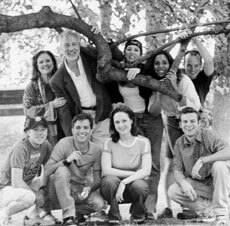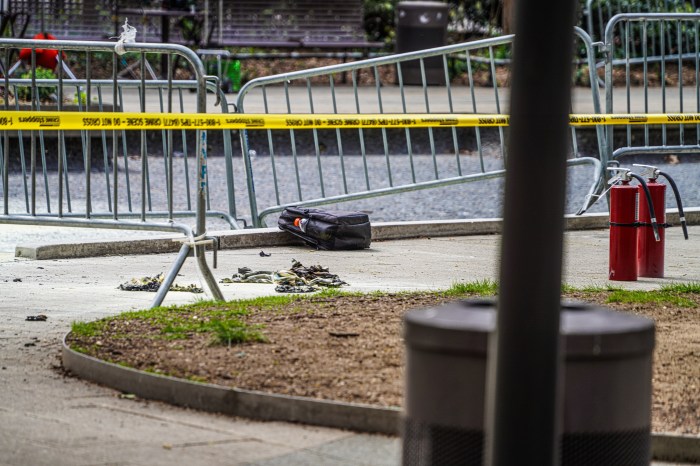The just-concluded festival underscores the vitality of live theater in NY
The Fringe Festival is a labor of love for all involved. For every “Urinetown” that first finds an audience in the sometimes difficult-to-find theaters, there are dozens of shows that after their brief and erratically scheduled runs disappear completely.
Yet the Fringe demonstrates more than any commercial theatrical venture that the art form is alive, vibrant and exciting and that there is still work worth doing that is not motivated by the balance sheet or financial projections of touring revenues.
At the Fringe, you pay your $15 and you take your chances, hoping that as you trek from venue to venue, the right buzz has alerted you to a sleeper hit so that you won’t waste one of your precious windows of opportunity on a flop. With nearly 200 productions mounted over a two-week festival, it can get a bit overwhelming. Where else, though, will you find small companies from around the globe who have a passionate commitment to their craft? Having often sat in Off-Off-Broadway houses where the cast outnumbered the audience, it is refreshing to see the excitement on people’s faces when at the last minute they get into a show off the waiting list or to hear people avidly arguing about issues raised by a show during intermission. It’s fun to start to see some of the same people over and over in the different audiences and develop a nodding acquaintance based on a shared, even if idiosyncratic, appreciation for what is intriguing in the roster of shows. During its life, the festival evolves as a kind of cultural theater and instant community that forms and then dissolves. Hopefully, that community will re-form the following year.
From a purely critical perspective, the shows tend to fall into three groups. First, there are the disasters, shows so utterly ill conceived, so badly produced and so wretchedly performed that even the most generous-hearted audience member is left groaning. This year’s poster child was the musical, “Die, Die Diana!” Banned in England because of its seditious content and getting plenty of publicity from its tabloid subject, the show never came close to its billing in terms of shock value. I would rather have spent the time listening to a garbage disposal eating a spoon than to have been held hostage by this horror a moment longer than necessary.
Other shows fall into the middle ground, characterized by interesting concepts, decent scripts and talented performers but ultimately weakened by narrow focus or a political agenda. “The First Step,” for its strong cast and moments of pure brilliance––a rap on suggestive AOL screen names being one of the most amusing––never really held together and seemed more like an intervention or a commercial for Sexual Compulsives Anonymous than a coherent play. “The Last Detail” was an incomplete and unnecessary stage adaptation of an obscure movie, which seemed more designed to allow the leader actor to do an extended, and inconsistent, Jack Nicholson imitation than to offer any kind of commentary on the human cost of war. Both of these shows were interesting but ultimately fell short of their potential.
And then there are the moments when you know you’re seeing something special. These are the shows you secretly hope to see every time you step up to a ticket table, and as the buzz gets around, they’re the ones where anxious people wait for an hour or more on the hope of getting a ticket. The things that might make you discount a lesser show—an empty stage, weak air conditioning, uneven casting for example—don’t matter because the theatrical experience transcends it all.
I saw only one show that did that for me this year—“Believe in Me… A Bigfoot Musical”—with a book by Adrien Royce based on her award-winning play and music and lyrics by Michael Holland. The quirky story is about a documentary filmmaker who struggles to do meaningful work in a commercial world but is forced to confront the possibility that even the things she believes in may not be true. In asking what is truth, the story is completely relevant for our times when it’s hard to know what story to trust and from whom, but it is also a love story that posits that real love is only possible when one lets go of the ego, trusts something and takes the risk that one’s heart may be broken.
Holland’s score is highly accomplished, his lyrics characteristically smart and wry. As an exceptional cabaret artist, Holland knows how to make each song a theatrical event, and his coherent score is highly sophisticated. The cast was mostly terrific, featuring the hugely talented Christina Norrup in the central role of Arlene, supported by such heavy hitters as Jamie Laverdiere, Audrey Lavine, David Gurland and Danielle Pratt, along with a remarkable ensemble.
There is work to be done on this show, but it is a diamond that is not so much in the rough as in need of a bit of polishing. One hopes that it will find another life and the broader audience it deserves.
One also hopes that those who attended The Fringe will continue to support live Off-Off-Broadway theater. It may not be as easy to find, but it is one of the riches of New York, one of the reasons to live here, and––who knows—you may even make a sighting of the next mainstream hit.
We also publish:




































